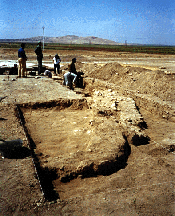
INTRODUCTION
Qinnasrin is the name of a famous city founded in the early Islamic period as the capital of the jund or province of north Syria. This city was located about 25 km south of the ancient city of Halab (Aleppo) and was associated with the Classical city of Chalcis ad Belum. Many scholars believe that the Islamic city continued within the walls of Byzantine Chalcis, now to be found next to the town of al-'Is.
In 1994, archaeologists from the University of Chicago noticed that few Islamic artifacts are found on Tell Chalcis. A few years later, a German archaeologist found Islamic remains in and around the town of Hadir, 4 km east of Chalcis. The name Hadir is very interesting because in pre-Islamic times this word had the meaning of an Arab camp. Such hadirs were located beside most Byzantine cities. In the case of Qinnasrin, when the Muslim authorities arrived, they settled in the Arab camp (hadir) and not in Chalcis. The town of Hadir became the misr or administrative center for the Umayyad government.
In 1998, an archaeological survey of Hadir revealed a wealth of ancient and Islamic remains. South of the town is the great mound of Tell Hadir; this was an ancient city of the Bronze and Iron Ages, from about 4000 years ago until the Seleucid foundation of Chalcis. South and north of Hadir, as well as in its center, are the remains of pre-Islamic buildings. These ruins may be associated with the Arab camp and possibly the Ghassanid dynasty. Two small excavations on the north of Hadir revealed an early Islamic occupation, from the Umayyad and Abbasid periods. A house was uncovered with two rooms; this building seems to be modeled on an Arab tent, which became a permanent dwelling. This house shows the settlement of Arabs in Qinnasrin and the growth of the city during the early Islamic period.
The future archaeological research in Hadir will attempt to discover more information on the beginnings of the Islamic city. The survey and soundings in 1998 were a joint project of the Department of Antiquities of Syria, represented by Ms. Fedwa Abidou, the University of Paris -- Sorbonne, represented by Prof. Marianne Barrucand, and The University of Chicago, directed by Dr. Donald Whitcomb. These participants hope to continue this research into the history of Qinnasrin and the development of early Islamic civilization.
Articles
- 2001 Article: LETTER FROM THE FIELD: IN SEARCH OF LOST MAR'ASH
- 1999 Article: DISCOVERING A NEW CITY IN SYRIA: HADIR QINNASRIN 1998

